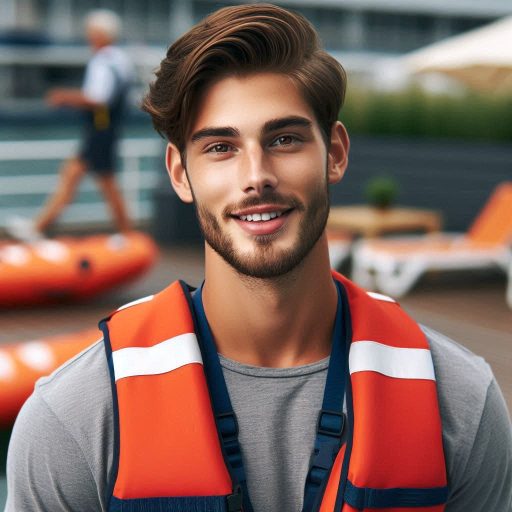Introduction
Understanding lifeguard safety protocols is crucial for maintaining a safe environment at aquatic facilities.
Lifeguards play a pivotal role in preventing water-related accidents and ensuring the well-being of swimmers.
This blog post will focus on the essential protocols and procedures that lifeguards must follow to effectively carry out their responsibilities.
Importance of Lifeguard Safety Protocols
Lifeguard safety protocols serve as a framework for maintaining order and proactively addressing potential risks at swimming pools, beaches, and other water bodies.
These guidelines are designed to prevent emergencies, minimize injuries, and facilitate timely responses in case of incidents.
Crucial Role of Lifeguards
Lifeguards are responsible for observing swimmers, identifying hazards, and responding to emergencies promptly.
Their vigilance and quick intervention can prevent drowning, injuries, and other water-related accidents.
By enforcing safety protocols, lifeguards create a secure environment for all patrons.
Focus on Essential Protocols and Procedures
This blog post will delve into the key protocols and procedures that every lifeguard should be familiar with.
From surveillance techniques to rescue operations, adherence to these guidelines is essential for ensuring effective water safety management.
By understanding and implementing these protocols, lifeguards can fulfill their duty of safeguarding lives and promoting a safe aquatic experience for all.
Qualifications and Training
The necessary certifications and qualifications for lifeguards
To become a lifeguard, candidates must meet specific qualifications and certifications.
Most pools and beaches require lifeguards to obtain a certification from a recognized organization.
Common certifications include the American Red Cross Lifeguarding Certification or the YMCA Lifeguard Training.
These programs ensure lifeguards learn essential skills, such as rescue techniques and water safety.
Importance of regular training sessions and drills
Regular training sessions and drills play a crucial role in a lifeguard’s effectiveness.
Lifeguards should participate in routine training to stay sharp and prepared for emergencies.
These sessions often include practicing rescue techniques, responding to simulated emergencies, and performing CPR drills.
Regular training helps lifeguards build muscle memory, ensuring they react swiftly and effectively during real-life situations.
The need for ongoing education on CPR and first aid
Ongoing education in CPR and first aid is vital for lifeguards.
Transform Your Career Today
Unlock a personalized career strategy that drives real results. Get tailored advice and a roadmap designed just for you.
Start NowLifeguards must be equipped to handle various medical emergencies, from minor injuries to life-threatening situations.
They should undergo periodic refresher courses to maintain their skills and knowledge.
Many organizations recommend lifeguards recertify their CPR and first aid skills every two years.
By emphasizing the need for continuous education, lifeguards remain competent and confident in their abilities.
Staying current with the latest techniques and protocols can significantly impact the safety of swimmers.
Lifeguards must adapt to new methods and guidelines, ensuring they provide the best care possible.
In summary, lifeguard qualifications and training encompass necessary certifications, regular drills, and ongoing education.
These components form a solid foundation for effective lifeguard performance.
Investing in comprehensive training ensures lifeguards are prepared to protect lives and respond to emergencies efficiently.
Read: Lifeguard Training: Tips for Effective Learning
Proper Equipment
Essential equipment that lifeguards should have on duty
As a lifeguard, having the right equipment is crucial to ensuring the safety of both swimmers and yourself.
Here are some essential pieces of equipment that lifeguards should have on duty:
- Rescue Tubes: Rescue tubes are a lifeguard’s primary rescue tool.
They should be readily accessible and in good working condition. - Whistles: Lifeguards should always have a whistle to alert swimmers of dangerous situations or to communicate with other lifeguards.
- First Aid Kit: A well-stocked first aid kit is essential for treating minor injuries and providing immediate care until medical help arrives.
- Spine Board: In case of spinal injuries, a spine board is necessary for safely immobilizing and transporting a victim from the water.
- Defibrillator: Having an AED (Automated External Defibrillator) on-site can save lives in case of sudden cardiac arrest.
- Backboard: Backboards are used for stabilizing victims with suspected spinal injuries during water rescues.
Proper Maintenance and Inspection of Rescue Equipment
Regular maintenance and inspection of rescue equipment are essential to ensure that they are in good working condition when needed.
- Inspect rescue tubes for any signs of wear and tear, and replace them if necessary.
- Check whistles regularly to ensure they are working properly and can be heard clearly.
- Restock first aid kits after each use and check the expiration dates of medications and supplies.
- Ensure that the spine board and backboard are stored properly and free from damage.
- Regularly test the defibrillator to ensure that it is in good working condition and properly charged.
Use of Personal Protective Gear for Lifeguards
Personal protective gear is essential for lifeguards to protect themselves while on duty.
Here are some important pieces of gear that lifeguards should always wear:
- Whistle and Lanyard: A whistle is crucial for signaling emergencies, while a lanyard keeps it secure and within reach.
- Sunscreen: Lifeguards spend long hours under the sun, so sunscreen is important to prevent sunburn and skin damage.
- Hat and Sunglasses: Protect your eyes and face from the sun’s glare with a hat and sunglasses.
- Proper Footwear: Lifeguards should wear comfortable and non-slip footwear to navigate wet pool decks and surfaces easily.
- Gloves: Wear gloves when handling rescue equipment or providing first aid to protect against infections and injuries.
- Uniform: A lifeguard uniform not only identifies you as a lifeguard but also provides protection and visibility to swimmers.
By having the proper equipment, maintaining and inspecting it regularly, and using personal protective gear, lifeguards can ensure the safety and well-being of both themselves and the swimmers under their watch.
Read: Lifeguard Training Tips: How to Excel and Succeed
Communication Protocols
Importance of clear communication among lifeguards
Effective communication is vital for lifeguards to ensure safety in and around the water.
Lifeguards must maintain clear communication with one another to respond swiftly to emergencies.
Miscommunication can lead to delays that jeopardize a swimmer’s safety.
Transform Your Career Today
Unlock a personalized career strategy that drives real results. Get tailored advice and a roadmap designed just for you.
Start NowTherefore, lifeguards should develop strong communication skills to convey important information quickly and efficiently.
The use of hand signals and whistle commands
Hand signals serve as a crucial tool for lifeguards.
In noisy environments, such as busy beaches or pools, lifeguards can use hand signals to alert each other.
For example, a raised arm can indicate a potential emergency.
Specific signals should be established during training to ensure everyone understands their meanings.
Lifeguards should practice these signals regularly to build familiarity and confidence in their use.
Whistle commands also play a significant role in communication.
A single blast typically signals attention, while multiple blasts may indicate an emergency.
Lifeguards must understand and follow these commands to maintain order.
Each lifeguard should remain alert to whistle signals, as they can direct actions during critical moments.
This clear system helps lifeguards coordinate their efforts and respond effectively.
Communication channels with other staff and emergency services
In addition to communication among lifeguards, channels must exist for interaction with other staff and emergency services.
Lifeguards should maintain contact with facility staff, such as managers or maintenance personnel.
This connection ensures that everyone is aware of ongoing safety protocols and procedures.
Lifeguards must also know how to communicate with emergency services when necessary.
Quick access to contact numbers can expedite the response time in emergencies.
In summary, clear communication among lifeguards is essential for safety.
Hand signals and whistle commands facilitate effective responses.
Additionally, lifeguards must maintain open communication channels with other staff and emergency services to ensure a comprehensive safety strategy.
Read: Essential Skills for Theater Ushers
Transform Your Career Today
Unlock a personalized career strategy that drives real results. Get tailored advice and a roadmap designed just for you.
Start Now
Vigilance and Surveillance
The need for constant vigilance and active surveillance
Lifeguards play a critical role in ensuring the safety of swimmers.
Constant vigilance and active surveillance are essential to this responsibility.
A lifeguard’s ability to spot potential dangers quickly can save lives.
Therefore, maintaining a proactive mindset is crucial.
Importance of scanning the entire pool or beach area regularly
Regularly scanning the entire pool or beach area is vital.
Lifeguards should divide their designated zones into sections.
By doing this, they ensure they do not overlook any part of their area.
This strategy helps them monitor multiple swimmers simultaneously.
Lifeguards should continuously move their heads and eyes to track all swimmers’ activities.
This technique aids in identifying any signs of distress or unsafe behavior.
Strategies for minimizing distractions and staying focused on monitoring swimmers
Minimizing distractions is also crucial for effective surveillance.
Lifeguards should avoid engaging in lengthy conversations while on duty.
Instead, they should keep communication brief and focused on safety.
Limiting the use of personal devices, like smartphones, can also enhance concentration.
A lifeguard must remain attentive to their surroundings at all times.
Implementing specific strategies can help maintain focus.
Lifeguards should create a routine for their scanning process.
This routine could include a systematic approach to scanning different sections of the pool or beach.
Taking breaks to refocus can also help maintain mental alertness.
They should practice self-discipline to remain aware of their environment, especially during peak times.
Transform Your Career Today
Unlock a personalized career strategy that drives real results. Get tailored advice and a roadmap designed just for you.
Start NowIn short, vigilance and surveillance are crucial aspects of lifeguarding.
Lifeguards must stay alert and proactive while monitoring their area.
By scanning effectively and minimizing distractions, they can ensure the safety of all swimmers.
This commitment to vigilance can significantly reduce the risk of accidents and enhance the overall safety of the environment.
Read: Lifeguard Professional Development Resources
Emergency Response Procedures
Step-by-step protocols for responding to emergencies
When it comes to lifeguard safety, knowing how to respond to emergencies is crucial.
Here are the step-by-step protocols to follow:
- Assess the Situation: Quickly evaluate the type and severity of the emergency.
- Assign Roles: Designate specific tasks to other lifeguards or bystanders to assist in the response.
- Activate Emergency Services: If needed, call 911 or alert the proper authorities immediately.
- Provide First Aid: Administer necessary medical assistance based on your training and certification.
- Establish Communication: Keep all parties informed and coordinated throughout the response effort.
- Monitor the Victim: Continuously assess the condition of the individual until help arrives.
- Control the Scene: Keep bystanders back and ensure a safe environment for the victim and responders.
- Initiate Rescue: If necessary, perform a water rescue using proper techniques and equipment.
Chain of Command and Delegation of Responsibilities
During an emergency, establishing a clear chain of command and delegation of responsibilities is vital.
Here’s how it should be done:
- Lifeguard in Charge: The designated leader who makes critical decisions and directs the response effort.
- Assistant Lifeguards: Support the lifeguard in charge by following instructions and providing assistance as needed.
- Communicator: Maintains communication with emergency services, relaying important information and updates.
- First Aid Provider: Administers medical aid to the victim in accordance with protocols and training.
- Scene Controller: Manages bystanders, controls the environment, and ensures safety for all involved.
Effective and efficient emergency response is essential for saving lives in critical situations.
By following these protocols and delegating responsibilities accordingly, lifeguards can effectively handle emergencies and ensure the safety of everyone involved.
Crowd Control and Behavior Management
Strategies for managing crowds and maintaining order
- Implement visible signage with safety guidelines for visitors to follow.
- Assign specific zones for different age groups or swim levels.
- Utilize whistle signals to communicate instructions effectively to the crowd.
- Maintain a consistent presence along the water’s edge to deter misbehavior.
- Proactively address any overcrowding situations to prevent potential accidents.
Dealing with Unruly Behavior
- Approach the individual calmly and assess the situation before intervening.
- Use clear and firm language to communicate expectations and consequences.
- Offer alternative activities or redirect the individual to prevent further disruption.
- Involve additional lifeguards or security personnel if the situation escalates.
- Document any incidents and follow up with appropriate disciplinary actions.
Enforcing Rules and Regulations
- Consistently remind visitors of the rules through announcements or visuals.
- Have a zero-tolerance policy for behaviors that jeopardize safety.
- Train lifeguards to enforce rules effectively while maintaining professionalism.
- Collaborate with management to make necessary adjustments to protocols.
- Communicate the importance of compliance to visitors to promote a safe environment.
Physical Fitness and Wellness
As lifeguards, physical fitness plays a crucial role in our ability to perform our duties effectively.
Here are some key points to consider:
Importance of Physical Fitness
- Enhances strength and endurance for water rescues
- Improves reaction time and coordination during emergencies
- Reduces the risk of injuries while on duty
Proper Hydration and Sun Protection
- Staying hydrated is essential for optimum performance
- Use sunscreen to protect against harmful UV rays
- Wear hats and sunglasses to shield eyes from the sun
Mental Wellness and Stress Management
- Recognize signs of stress and seek support when needed
- Practice relaxation techniques such as deep breathing exercises
- Maintain a healthy work-life balance to prevent burnout
By prioritizing physical fitness, hydration, sun protection, and mental wellness, lifeguards can ensure they are in peak condition to respond to any emergencies that may arise.
Post-Incident Protocols and Reporting
Once an incident occurs, it is crucial for lifeguards to follow specific protocols for documenting and reporting the event.
This not only ensures accountability but also helps in improving overall safety measures at the facility.
Procedures for Documenting and Reporting Incidents
- Immediately assess the situation and ensure the safety of all individuals involved.
- Record detailed information about the incident, including the date, time, location, and individuals present.
- Document any injuries sustained, actions taken, and any witnesses to the incident.
- Report the incident to the appropriate authorities, such as the supervisor or management team.
- Follow any specific reporting protocols set by the facility or organization.
Importance of Debriefing Sessions After Critical Incidents
After a critical incident, it is essential to conduct debriefing sessions with all involved parties.
These sessions serve multiple purposes, including:
- Providing a safe space for lifeguards to process their emotions and experiences.
- Allowing for open communication about what occurred during the incident.
- Identifying any areas for improvement in protocols or procedures.
- Promoting teamwork and solidarity among lifeguard staff.
- Offering support and resources for those who may be struggling with the aftermath of the incident.
Role of Continuous Improvement and Learning from Past Experiences
Every incident, whether minor or critical, presents an opportunity for learning and growth.
Lifeguards should actively participate in continuous improvement efforts by:
Transform Your Career Today
Unlock a personalized career strategy that drives real results. Get tailored advice and a roadmap designed just for you.
Start Now- Reviewing incident reports and identifying trends or recurring issues.
- Implementing changes to protocols or procedures based on lessons learned from past experiences.
- Participating in ongoing training and development programs to enhance skills and knowledge.
- Encouraging a culture of accountability and responsibility among lifeguard staff.
- Celebrating successes and milestones in improving overall safety and response times.
By following these post-incident protocols and emphasizing the importance of reporting, debriefing sessions, and continuous improvement, lifeguards can contribute to a safer and more efficient aquatic environment for all patrons and staff.
Conclusion
Lifeguard safety protocols and procedures are essential for ensuring the well-being of swimmers and beachgoers.
By following these protocols, lifeguards can effectively respond to emergencies and prevent accidents.
It is crucial to reinforce the importance of adhering to established protocols to minimize risks and maintain a safe environment at the beach or pool.
Consistent training and education are key in enhancing lifeguards’ skills and preparedness for any situation that may arise.
Overall, the safety of individuals at the beach or pool heavily relies on lifeguards’ vigilance and adherence to safety protocols.
By continuously improving their knowledge and abilities, lifeguards can be better equipped to handle emergencies and protect those under their watch.




